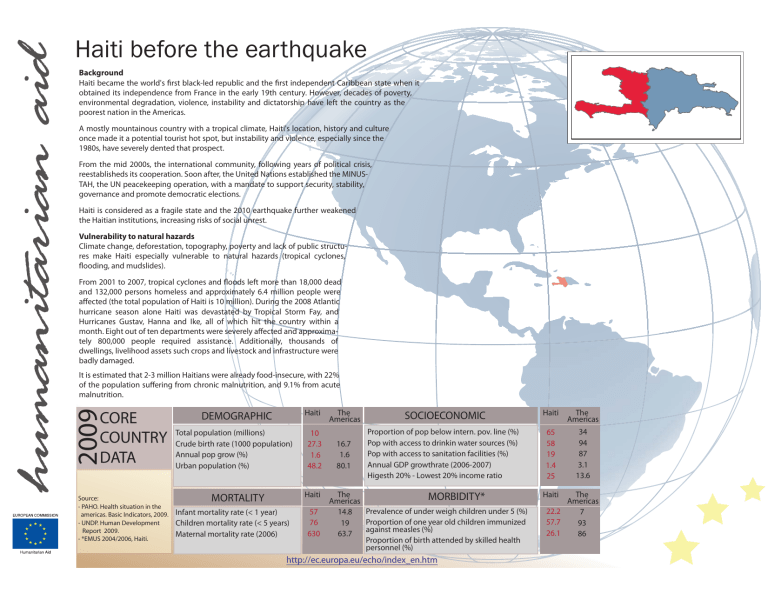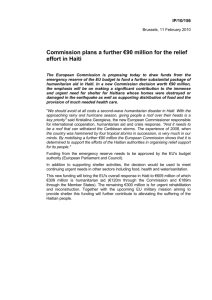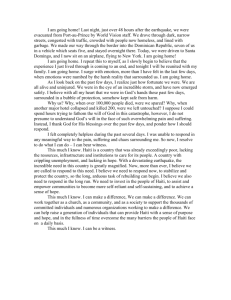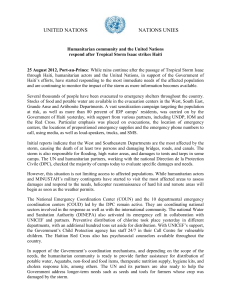Haiti before the earthquake
advertisement

Haiti before the earthquake Background Haiti became the world's first black-led republic and the first independent Caribbean state when it obtained its independence from France in the early 19th century. However, decades of poverty, environmental degradation, violence, instability and dictatorship have left the country as the poorest nation in the Americas. A mostly mountainous country with a tropical climate, Haiti's location, history and culture once made it a potential tourist hot spot, but instability and violence, especially since the 1980s, have severely dented that prospect. From the mid 2000s, the international community, following years of political crisis, reestablisheds its cooperation. Soon after, the United Nations established the MINUSTAH, the UN peacekeeping operation, with a mandate to support security, stability, governance and promote democratic elections. Haiti is considered as a fragile state and the 2010 earthquake further weakened the Haitian institutions, increasing risks of social unrest. Vulnerability to natural hazards Climate change, deforestation, topography, poverty and lack of public structures make Haiti especially vulnerable to natural hazards (tropical cyclones, flooding, and mudslides). From 2001 to 2007, tropical cyclones and floods left more than 18,000 dead and 132,000 persons homeless and approximately 6.4 million people were affected (the total population of Haiti is 10 million). During the 2008 Atlantic hurricane season alone Haiti was devastated by Tropical Storm Fay, and Hurricanes Gustav, Hanna and Ike, all of which hit the country within a month. Eight out of ten departments were severely affected and approximately 800,000 people required assistance. Additionally, thousands of dwellings, livelihood assets such crops and livestock and infrastructure were badly damaged. 2009 It is estimated that 2-3 million Haitians were already food-insecure, with 22% of the population suffering from chronic malnutrition, and 9.1% from acute malnutrition. CORE COUNTRY DATA Source: - PAHO. Health situation in the americas. Basic Indicators, 2009. - UNDP. Human Development Report 2009. - *EMUS 2004/2006, Haiti. Haiti DEMOGRAPHIC Total population (millions) Crude birth rate (1000 population) Annual pop grow (%) Urban population (%) 10 27.3 1.6 48.2 Haiti MORTALITY Infant mortality rate (< 1 year) Children mortality rate (< 5 years) Maternal mortality rate (2006) 57 76 630 The Americas SOCIOECONOMIC Haiti The Americas 16.7 1.6 80.1 Proportion of pop below intern. pov. line (%) Pop with access to drinkin water sources (%) Pop with access to sanitation facilities (%) Annual GDP growthrate (2006-2007) Higesth 20% - Lowest 20% income ratio 65 58 19 1.4 25 34 94 87 3.1 13.6 The MORBIDITY* Americas Prevalence of under weigh children under 5 (%) 14.8 Proportion of one year old children immunized 19 against measles (%) 63.7 Proportion of birth attended by skilled health personnel (%) http://ec.europa.eu/echo/index_en.htm Haiti The Americas 22.2 7 57.7 93 26.1 86 Haiti before the earthquake EARTHQUAKE 81Million € Humanitarian assistance in Haiti: 81 million €, 1995 - 2009 1995 ... 2009 BEFORE THE QUAKE 25 € RESPONSE CONSOLIDATION IMMEDIATE RESPONSE ... Floods/ Cyclones 28% Social crisis 65% 15 € 10 € 5€ 0€ 1995 1996 1997 1998 1999 2001 2002 2003 2004 2005 2006 2007 2008 The European Commission, through its Humanitarian Department, DG ECHO, has been supporting vulnerable populations in Haiti for the last 15 years. This assistance, totalling approximately 81 MEUR, has focused on responding to the emergency needs caused by natural hazards and socio-economic crisis, as well as disaster risk reduction. DG ECHO responded swiftly at the end of the 1990s and in 2004 to social and economic problems caused by political instability, to the 2004 hurricanes and floods in the countryside and Gonaives, and to the three consecutive hurricanes in 2008. In 2008, due to the high level of vulnerability that was identified in the country, DG ECHO re-opened a field office to more closely manage humanitarian operations and step up efforts to identify and address malnutrition and mother-child mortality through a comprehensive multi- sector response. http://ec.europa.eu/echo/index_en.htm AUG 2011 CARE MAINTENANCE & TRANSITION DRR 7% 20 € Million JAN 2010 ... MAR APR ... SEPT 2010 2009 € 120Million ECHO 2010 Haiti earthquake Earthquake Response EARTHQUAKE 90Million € 30Million € 1995 N o r d - O u e st ... 2009 BEFORE THE QUAKE JAN 2010 ... MAR APR ... SEPT 2010 IMMEDIATE RESPONSE RESPONSE CONSOLIDATION ... AUG 2011 CARE MAINTENANCE & TRANSITION Nord G LOBAL QUAKE FIGURES GLOBAL ((1) (1) N o r d - Est D 222,750 dead D 105,000 houses destroyed and 208,000 houses damaged D 60% of hospitals destroyed D Around 5,000 schools destroyed (23% of the total of Haiti) D Affected population (estimation): 3 million D Displaced people in settlements up to 1.7 million D Total impact cost around USD 7.8 Billion = 2009 GDP Ar t i b oni t e (1) Source: Government of Haiti Ce n t r e ACHIEVEMENTS D Adequate coverage of basic needs rapidly ensured including: Access to life-saving health services Emergency Shelter distribution in camps and host families Water distribution and access to sanitation facilities General food distribution and blanket preventive supplementary feeding D Avoidance of malnutrition increase, epidemics outbreaks and potential civil unrest D Reduction of vulnerability in camps CONSTRAINTS Port-au-Pr rt-a ince G r a n d ' A n se Ouest Su d Sud-Est HUMANITARIAN AID D Amount: EUR 30 million (EUR 3 million immediate assistance + EUR 19 million emergency assistance + EUR 8 million refocussed from pre-earthquake funding) D Beneficiaries: 2,830,000 DG ECHO IMMEDIATE RESPONSE D Unprecedented size and complexity of a crisis in an urban context (capital city) D High toll of the earthquake on national authorities and humanitarian actors capacities D Lack of accurate information on needs and ongoing response D Complexity of population movements and fluctuation: camps/spontaneous sites/ sheltered population/migration at national level D Needs on Emergency Shelter exceeding global humanitarian stocks D National health system overwhelmed D Lack of logistic means (transportation, warehousing and communication) and access (rubble removal and roads) D Perception of security issues CIVIL PROTECTION D 25 European countries involved in the relief effort and channeling assistance through the EU Civil Protection Mechanism (MIC). (MIC) through D Geographical areas of intervention: Port au Prince; Gressier/Leogane/Jacmel Triangle; National (Coordination & Logistics) D 3 EU Civil Protection Teams were deployed on site to coordinate European assistance, carry out needs assessments and support the international relief effort in close cooperation with the UN. D Sectors Se of intervention: Shelter, Camp Management, Non Food Items, Water, Sa Sanitation and Hygiene, Health & Orthopedics, Nutrition, Food Assistance, Co Coordination and Logistics/Telecommunications, Protection, Disaster Risk Re Reduction D The Civil Protection assistance included 12 urban search and rescue teams, 7 assessment teams, 38 medical teams and supplies, 2 field hospitals, shelter, 6 water sanitation units, 2,334 tents for approximately 20,000 persons and 1 Base-camp with a capacity of 300 people. D Pa Partners: C directly d D In addition to coordinating Member States' assistance, the EC deployed a z UN: U OCHA, UNOPS, PAHO, WFP gery. water purification unit and 5 advanced medical posts with surgery. z Red R Cross National Societies: Spanish, German, French, Finnish, Austrian D EU co-financing for transport of assistance requested orr approved so far reaches z IINGO: OXFAM GB, MdM, TSF, ACF, ACTED, AMI, CARE, CONCERN, HANDICAP BEL,, a total amount of EUR 4.5 million. HANDICAP FR, JOHANNITER, MALTESER, MapAction, PLAN, RedR, SOLIDARITÉS, H W Welt Hunger Hilfe hp://ec.europa.eu/echo/index_en.htm h p://ec.eeuropa.eeu/echo/index_een.h htm € 120Million ECHO 2010 Haiti earthquake Earthquake Response EARTHQUAKE Immediate response 1995 ... 2009 BEFORE THE QUAKE DRR 5% Food 22% JAN 2010 ... MAR APR ... SEPT 2010 IMMEDIATE RESPONSE RESPONSE CONSOLIDATION ... AUG 2011 CARE MAINTENANCE & TRANSITION Health 17% 1.5 M€ 5.2 M€ Shelter: 7.8 M€ 6.6 M€ 6 M€ Coordination & logistics, 10% 90Million € 30Million € Water 20% 3 M€ Health: 5.2 M€ Disaster Risk Reduction: 1.5 M€ D Reduction of vulnerability through: Community based disaster preparedness (DIPECHO) Hurricane preparedness Mitigation works in camps Advocacy for building back better DCamp Management and Protection: Site identification, site planning and reorganization Coordination and data collection in camps and sites (including security) 7.8 M€ Shelter 26% DEmergency Shelter: Distribution of tents, plastic sheeting and building materials Distribution of Non Food Relief Items: jerry cans, blankets, kitchen sets, mosquito nets, etc. DProvision of primary health care services (preventive and curative) in the directly affected areas through: Emergency Response Units (basic health care unit and cirurgical unit) Mobile clinics Support to existing health facilities Support to orthopedics, prosthetics and physiotherapy programmes Psychosocial support and “baby tents” DProvision of essential medicines and medical supplies to national authorities and humanitarian actors DSupport to Health Cluster coordination Food: 6.6 M€ D Food: Provision of Ready to Eat Meals (January 2010) Contribution to the global response targeting 4.5 million monthly food rations (February and March 2010) Food and/or Cash For Work activities (April 2010 onwards) D Nutrition: Treatment and prevention of acute malnutrition in settlements (Ready to Use Therapeutic Food) Blanket supplementary feeding for under-5s Vouchers for access to fresh food available in markets Breast feeding promotion Water, sanitation & hygiene: 6 M€ Coordination & logistic : 3 M€ D Water Distribution of safe water Chlorination of water Distribution of buckets DCoordination: Support to general humanitarian coordination including data collection, needs assessment, coordination of response and mapping. Security coordination and training DLogistics: Provision of joint logistical services for all humanitarian actors: air, sea and land transport and warehouse facilities. Import facilitation Facilitation of communication between humanitarian actors and military actors Provision and establishment of telecommunications for humanitarian actors Provision of free telecommunication services for affected population DSanitation & Hygiene: DSanit Pro Provision of emergency latrines Pro Provision of de-sludging trucks Dis Distribution of hygiene kits Hy Hygiene promotion and training of promoters http://ec.europa.eu/echo/index_en.htm € 120Million ECHO Beyond the immediate response Earthquake Response EARTHQUAKE 30Million € What are we doing? 1995 ... 2009 BEFORE THE QUAKE Amount: Beneficiaries: 90 million € 4 million Areas of intervention: Port-au-Prince; Gressier/Leogane/Jacmel Triangle; Provinces hosting displaced population; National. Sectors of intervention: Shelter, Camp Management, Non Food Items, Water Sanitation and Hygiene, Health, Nutrition, Food Assistance, Coordination and Logistics, Protection, Disaster Risk Reduction. Constraints/ pending: D Delays in Temporary Shelter solutions (land ownership issues, rubble removal in individual plots, lack of suitable public land for organized new temporary settlements) D Lack of urban development strategy (mainly Port-au-Prince) D Waste management D Hurricane season and emergency preparedness D Complexity of the transition between acute emergency and reconstruction/development D Political and security context requiring presence of UN stabilization mission JAN 2010 ... MAR APR ... SEPT 2010 IMMEDIATE RESPONSE RESPONSE CONSOLIDATION 90Million € ... AUG 2011 CARE MAINTENANCE & TRANSITION ZONE 4 National - Transversal Food Assistance & Nutrition Shelters & Non Food Relief Items, Camp Management and Protection Coordination & Logistics Disaster Risk Reduction Health ZONE 3 Areas hosting IDPs 4% Food Assistance & Nutrition Shelters & Non Food Relief Items, Camp Management and Protection Water, Sanitation & Hygiene Health Disaster Risk Reduction Disaster Risk Reduction Coordination & Logistics 11 % 18 % Health ZONE 1 Port-au-Prince Water, Sanitation & Hygiene 30 % Food Assist & Nutrition 34 % Shelter 90 million € Funds committed http://ec.europa.eu/echo/index_en.htm 48% 23% 13% 8% 8% 10% Food Assistance & Nutrition 57% Water, Sanitation & Hygiene 30% Health 7% Shelters & Non Food Relief 6% Items, Camp Management and Protection ZONE 2 Affected areas out of PaP 3% 32% Shelters, Non Food Relief Items, Camp Management and Protection Water, Sanitation & Hygiene Health Food & Nutrition 24% 36% 33% 16% 13% 2% 34% 50% 33% 15% 2% € 120Million ECHO Beyond the immediate response 30Million € What are we doing? 1995 ... 2009 JAN 2010 ... MAR APR ... SEPT 2010 Challenges Actions Background date large numbers of people are still living in emergency shelters in spontaneous settlements, however building assessments and population profiling in camps have contributed to stabilize a precarious situation RESPONSE CONSOLIDATION IMMEDIATE RESPONSE FOOD & NUTRITION 90Million € ... AUG 2011 CARE MAINTENANCE & TRANSITION WATER SANITATION & D Food Assistance: Pre-earthquake general food insecurity and high dependency HYGIENE SHELTER BEFORE THE QUAKE To Earthquake Response EARTHQUAKE Before the earthquake access to water supply was highly limited with insufficient quantity and quality and deficient water networks. Since January a large amount of water has been distributed. on imports Earthquake temporarily disrupted local markets and imports and destroyed livelihoods assets Emergency food distributions not sustainable and disrupting local markets D Nutrition: Emergency response avoided an increase in acute malnutrition, remaining below alert threshold Chronic malnutrition remains a concern Temporary Shelter and/or definitive housing solutions through: Social mobilization to promote return to non-affected houses. Retrofitting to repair slightly damaged houses Installation of temporary shelters on original plots, after having solved legal issues, ownership, renting agreements, rubble removal; to be done in an integrated neighborhood approach with provision of basic and community services (water, sanitation, livelihood) Provision of Transitional Shelter for new organized settlements D Food Assistance: Unprecedented cash for work program oriented to rubble Urban crisis context: Scarce land, swampy or floodable zones, large informal suburbs and slums, inadequacy of existing infrastructure (sewage and drainage, roads, water and electricity network) Build Back Better requirements (technically and socially expensive and time consuming) Insufficient rubble removal assets Difficulties of operationalizing an urban development strategy D Food Assistance: Continue to support agriculture and reinforce positive 2010 removal, risk reduction and protection of livelihoods at national level and with community focus Support agricultural recovery (seeds and tools) Reconstitution of livelihoods assets in affected areas (urban and rural) D Nutrition: Nutritional program for children under-5, pregnant women and breast feeding mothers production trends Avoid disrupting markets that have recovered (food prices stability) Continue to monitor food and nutrition vulnerabilities Ensure transition from Cash For Work to formal and stable employment D Nutrition: To promote and strengthen a holistic and multi-sector approach (Health, Water and Food Security) to reduce nutritional vulnerability Production, management and diffusion of accurate data http://ec.europa.eu/echo/index_en.htm DWater: Support to the coordination of the distribution Potable water trucking distribution Support to the coordination of alternative solutions to water trucking: water network repairs, boreholes, connections, tank rehabilitation Rehabilitation of springs, water sources, catchment systems Provision of water and sanitation in rehabilitated schools Chlorination of water Distribution of buckets D Sanitation & Hygiene: Support to the provision of de-sludging services in collaboration with other humanitarian actors and national authorities. Clean-up campaigns in settlements Provision of latrines and hygiene promotion Switching from emergency free water distribution to neighborhood coverage, linking this to development of an accessible and sustainable water system service regulated by the national authorities. Establishment of a formal waste management system € 120Million ECHO Beyond the immediate response 30Million € What are we doing? 1995 ... 2009 JAN 2010 ... MAR APR ... SEPT 2010 Background The existing health system was precarious with very low coverage rates, high inequity and suffering from a lack of adequate human resources and founds The earthquake increased the pressure on the health system adding new vulnerable groups Actions Improvement of access to quality health care as well as mental health and psychosocial support Support to orthopedics and prosthetics program Provision of primary health care Clinic rehabilitation Mobile clinics Training IMMEDIATE RESPONSE ... AUG 2011 CARE MAINTENANCE & TRANSITION RISK REDUCTION & LOGISTIC RESPONSE CONSOLIDATION 90Million € DISASTER HEALTH COORDINATON BEFORE THE QUAKE Earthquake Response EARTHQUAKE Coordination: The presence of a large number of humanitarian organizations in the country underlines the key importance of achieving a coordinated humanitarian response. DG ECHO staff, together with other major donors, has been critical in advocating for strong humanitarian leadership D Coordination is being also supported through ECHO’s partners, aiming at: Harmonization of coordination mechanisms Implementation of the Humanitarian Reform Inter-agency collaboration Facilitating communication between humanitarian actors and military actors Collection, processing and dissemination of data Production of situation reports Build back better Frequency of disasters has eroded local and national capacities increasing the population’s vulnerability. Institutional capacities were slowly developing in the country, nevertheless the earthquake showed the urgency in strengthening preparedness and response Capacity building and reinforcement of the Haitian Red Cross and the Haitian Civil Protection System Community awareness and preparedness Advocacy for including risk reduction into the humanitarian, rehabilitation and reconstruction phases DLogistics: common logistics services have been provided to humanitarian actors (warehouse, trucks, boats) Ensuring that access to basic health care is provided by the state system rather than by NGO mobile clinics system Mapping new health capacities in the country and elaborating an appropriate exit strategy Bringing health care to new settlements Private versus public health system National capacities still insufficient (means, infrastructure, weak information system, human resources) Inclusion of orthopedic care and physioterapy into the national health structure Challenges The very different level of expertise and profile of actors as well as the high turnover of staff and inadequate language skills challenges the quality, effectiveness and efficiency of the response The location of coordination platforms in military bases reduces access by local authorities and civil society The emergency logistical system put in place is no longer valid for the reconstruction process; there is a need to improve the imports and customs system http://ec.europa.eu/echo/index_en.htm 2010 hurricane season Integration of risk reduction into multi-sector plans and making Build Back Better a real priority Absorption and technical capacities of stakeholders in the country Coordination of multitude of projects and programs In the aftermath of the quake Envisaged DG ECHO strategy onwards rds Health & Nutrition D To promote and strengthen a holistic and multi-sector approach in reproductive health and to reduce nutritional vulnerability D Production, formatting and diffusion of accurate data Post earthquake multi-sectorial assistance D Continued support to earthquake affected population D Integrated neighborhood based approach DG ECHO investing further into consolidated exit strategy Disaster Risk Reduction (DRR) D Linking Relief, Rehabilitation and Development (LRRD) processes. D Response to new events D Consolidation and integration in DG ECHO’s interventions D Strengthening a common DRR approach accross European Union instruments Reconstruction € 460 million 100 million 200 million 100 million 60 million The European Commission has pledged € 460 million for Haiti’s’ reconstruction (New York conference 31.03.2010). early non-humanitarian package focused on restoring government capacity (including €20 million from the Instrument for Stability) be reprogrammed from the Development Cooperation Programme increase to the Development Cooperation Programme for unforseen needs to be made available http://ec.europa.eu/echo/index_en.htm




